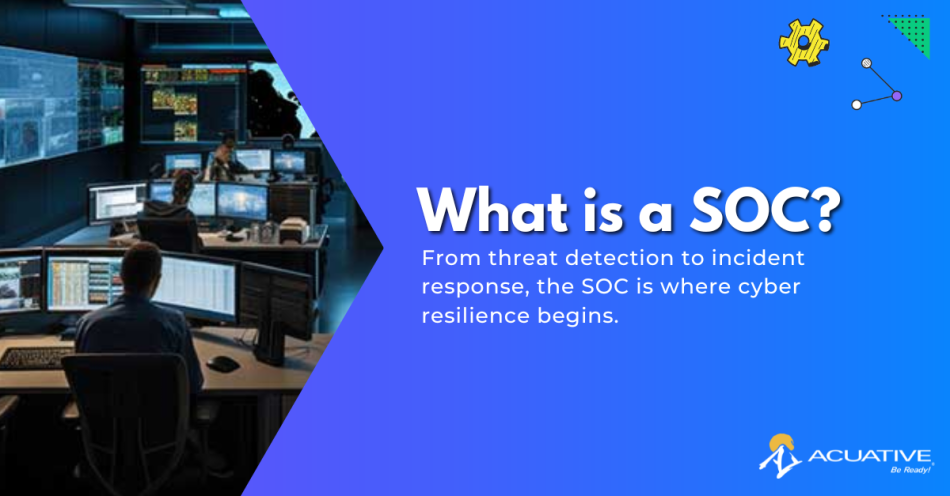Erik Johnson
Cyberattacks can come from anywhere, at any time. Whether it’s ransomware, phishing, or unauthorized access, the key to staying protected is continuous vigilance. That’s where a Security Operations Center (SOC) comes in.
If you’ve ever asked, “What is a SOC?”, you’re not alone. And no, it's not just a piece of clothing you wear on your feet. In this article, we’ll explore what a SOC is, why it matters, how it works, and why businesses, especially in high-risk industries like retail, healthcare, banking, and manufacturing. can benefit from a managed SOC model.
What is a SOC and How Do They Work?
A Security Operations Center (SOC) is a centralized team, either in-house or provided by a third party, that monitors, detects, analyzes, and responds to cybersecurity threats in real time. The SOC acts as the nerve center of an organization’s security efforts, providing around-the-clock protection for digital assets, infrastructure, and sensitive data.
To do this effectively, a SOC relies on a suite of technologies and processes that work together to provide visibility and control across the IT environment. These include:
- Security Information and Event Management (SIEM): Aggregates and correlates log data from various systems to detect anomalies and threats.
- Endpoint Detection and Response (EDR): Monitors activity on devices like laptops, desktops, and servers to catch malicious behavior.
- Threat Intelligence Platforms: Continuously gather data on emerging threats and tactics used by cybercriminals.
- Intrusion Detection and Prevention Systems (IDPS): Identify and block malicious traffic before it causes harm.
- Vulnerability Management Tools: Scan systems to find and prioritize security weaknesses before attackers do.
- Automation and Orchestration (SOAR): Streamline threat response workflows and reduce manual effort for faster remediation.
Together, these tools enable the SOC team to monitor the entire threat landscape, respond quickly to incidents, and continuously improve security posture through data-driven insights.
Why Is a SOC Important?
Cybersecurity is no longer a “set it and forget it” function. With threats becoming more advanced and persistent, constant monitoring and rapid response are critical to minimizing damage and avoiding costly downtime.
Consider the data:
- According to IBM’s Cost of a Data Breach Report 2023, the average global cost of a data breach reached $4.45 million, a 15% increase over the past three years.
- Organizations that detected and contained breaches in less than 200 days saved an average of $1.76 million compared to those that took longer.
- Sectors like healthcare and financial services experienced the highest breach costs, with healthcare averaging $10.93 million per incident.
- The retail industry saw a 20% increase in reported data breaches year-over-year, with threat actors targeting payment systems and customer data.
- In manufacturing, cyberattacks often led to operational disruption, not just data loss—putting both revenue and worker safety at risk.
A Security Operations Center helps businesses respond faster, limit the scope of attacks, and restore operations quickly, minimizing financial loss, brand damage, and regulatory fallout.
For high-activity industries like retail, healthcare, banking, and manufacturing, where sensitive data and operational continuity are mission-critical, a SOC is more than an IT function - it’s a business imperative.
Should You Use a Managed SOC? Pros and Cons
Building and staffing an in-house SOC is a massive undertaking—both technically and financially. That’s why many businesses choose to partner with a Managed Security Service Provider (MSSP) that offers SOC-as-a-Service.
Pros of a Managed SOC:
- 24/7 monitoring without staffing overhead
- Access to top-tier cybersecurity talent and tools
- Faster incident detection and resolution
- Predictable costs and flexible scale
- Quicker compliance readiness
Cons to Consider:
- Less direct control (though a good provider offers full transparency)
- Dependence on third-party SLAs
- Integration complexity (if not handled well)
For organizations in retail, healthcare, banking, and manufacturing, where internal IT teams are often stretched thin, a Managed SOC offers peace of mind and practical protection—without the cost of building one from scratch.
Who Works in a SOC? Roles and Responsibilities
A typical SOC is staffed by a multidisciplinary team of cybersecurity professionals, each playing a specific role in defending the organization:
- SOC Analyst (Tier 1–3): Monitors alerts, investigates threats, and escalates incidents.
- Security Engineer: Maintains and tunes tools like SIEMs, firewalls, and intrusion detection systems.
- Threat Hunter: Proactively searches for undetected threats using behavioral analysis and threat intelligence.
- Incident Responder: Leads containment, mitigation, and recovery during cyber events.
- SOC Manager: Oversees operations, staffing, reporting, and strategic security alignment with business goals.
Each role is essential to ensuring a fast, coordinated, and effective defense posture.
Ready for a Stronger Security Posture?
Acuative’s Managed SOC provides enterprise-grade cybersecurity monitoring and response—without the complexity of building it yourself. We deliver scalable protection, compliance support, and real-time visibility, tailored to the needs of today’s most targeted industries.
No matter what industry you're in, our SOC helps you stay ahead of threats—so your teams can focus on what they do best.
Contact us today to learn how our SOC services can protect your business and give you the confidence to operate securely, 24/7.
Protect Your Network with Acuative
About Erik Johnson
 With over 20 years of experience in cybersecurity and enterprise leadership, Erik Johnson is a strategic leader known for building lasting impact through innovation, team development, and operational excellence. Throughout his career, he has consistently turned challenges into opportunities by founding and scaling departments, leading high-performing teams, and driving transformation in complex business environments. His leadership is rooted in stability, but guided by a relentless pursuit of progress, making him a trusted voice in cybersecurity strategy and organizational growth.
With over 20 years of experience in cybersecurity and enterprise leadership, Erik Johnson is a strategic leader known for building lasting impact through innovation, team development, and operational excellence. Throughout his career, he has consistently turned challenges into opportunities by founding and scaling departments, leading high-performing teams, and driving transformation in complex business environments. His leadership is rooted in stability, but guided by a relentless pursuit of progress, making him a trusted voice in cybersecurity strategy and organizational growth.

